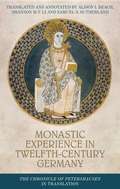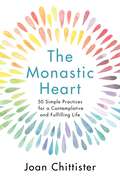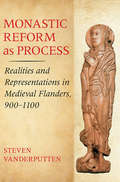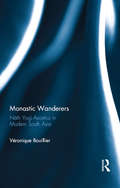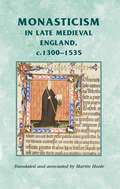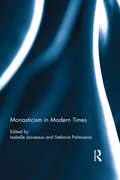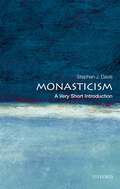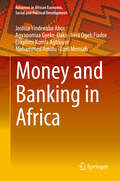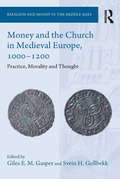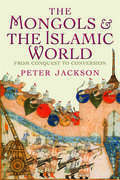- Table View
- List View
A Monastery in Time: The Making of Mongolian Buddhism
by Caroline Humphrey Hurelbaatar UjeedA Monastery in Time is the first book to describe the life of a Mongolian Buddhist monastery—the Mergen Monastery in Inner Mongolia—from inside its walls. From the Qing occupation of the eighteenth and nineteenth centuries through the Cultural Revolution, Caroline Humphrey and Hürelbaatar Ujeed tell a story of religious formation, suppression, and survival over a history that spans three centuries. Often overlooked in Buddhist studies, Mongolian Buddhism is an impressively self-sustaining tradition whose founding lama, the Third Mergen Gegen, transformed Tibetan Buddhism into an authentic counterpart using the Mongolian language. Drawing on fifteen years of fieldwork, Humphrey and Ujeed show how lamas have struggled to keep Mergen Gegen’s vision alive through tremendous political upheaval, and how such upheaval has inextricably fastened politics to religion for many of today’s practicing monks. Exploring the various ways Mongolian Buddhists have attempted to link the past, present, and future, Humphrey and Ujeed offer a compelling study of the interplay between the individual and the state, tradition and history.
Monastic And Religious Orders In Britain, 1000-1300 (PDF)
by Janet E. BurtonThis book traces the development of monasticism in England, Scotland and Wales from the last half century of Anglo-Saxon England to 1300. It explores the nature of the impact of the Norman settlement on monastic life, and how Britain responded to new, European ideas on monastic life. In particular, it examines Britain's response to the needs of religious women. It covers every aspect of the life and work of the religious orders: their daily life, the buildings in which they lived, their contribution to intellectual developments and to the economy. Particular attention is paid to the relationship between religious houses and their founders and patrons. This shows the degree of dependence of religious houses on local patrons. Indeed, one major theme which emerges from the book is the constant tension between the ideals of monastic communities and the demands of the world.
Monastic experience in twelfth-century Germany: The Chronicle of Petershausen in translation
by Alison I. Beach Shannon M. Li Samuel SutherlandMonastic experience in twelfth-century Germany provides a rare window on to monastery life in the tumultuous world of twelfth-century Swabia. From its founding in 992 through the great fire that ravaged it in 1159 and beyond, Petershausen weathered countless external attacks and internal divisions. Supra-regional clashes between emperors and popes played out at the most local level. Monks struggled against overreaching bishops. Reformers introduced new and unfamiliar customs. Tensions erupted into violence within the community. Through it all the anonymous chronicler struggled to find meaning amid conflict and forge connections to a shared past, enlivening his narrative with colorful anecdotes – sometimes amusing, sometimes disturbing. Translated into English for the first time, this fascinating text is an essential source for the lived experience of medieval monasticism.
Monastic experience in twelfth-century Germany: The Chronicle of Petershausen in translation
by Alison I. Beach Shannon M. Li Samuel SutherlandMonastic experience in twelfth-century Germany provides a rare window on to monastery life in the tumultuous world of twelfth-century Swabia. From its founding in 992 through the great fire that ravaged it in 1159 and beyond, Petershausen weathered countless external attacks and internal divisions. Supra-regional clashes between emperors and popes played out at the most local level. Monks struggled against overreaching bishops. Reformers introduced new and unfamiliar customs. Tensions erupted into violence within the community. Through it all the anonymous chronicler struggled to find meaning amid conflict and forge connections to a shared past, enlivening his narrative with colorful anecdotes – sometimes amusing, sometimes disturbing. Translated into English for the first time, this fascinating text is an essential source for the lived experience of medieval monasticism.
The Monastic Footprint in Post-Reformation Movements: The Cloister of the Soul (Routledge Methodist Studies Series)
by Kenneth C. CarveleyThis book examines the influence of the monastic tradition beyond the Reformation. Where the built monastic environment had been dissolved, desire for the spiritual benefits of monastic living still echoed within theological and spiritual writing of the seventeenth and eighteenth centuries as a virtual exegetical template. The volume considers how the writings of monastic authors were appropriated in post-Reformation movements by those seeking a more fervent spiritual life, and how the concept of an internal cloister of monastic/ascetic spirituality influenced several Anglican writers during the Restoration. There is a careful examination of the monastic influence upon the Wesleys and the foundation and rise of Methodism. Drawing on a range of primary sources, the book will be of particular interest to scholars of monastic and Methodist history, and to those engaged in researching ecclesiology and in ecumenical dialogues.
The Monastic Footprint in Post-Reformation Movements: The Cloister of the Soul (Routledge Methodist Studies Series)
by Kenneth C. CarveleyThis book examines the influence of the monastic tradition beyond the Reformation. Where the built monastic environment had been dissolved, desire for the spiritual benefits of monastic living still echoed within theological and spiritual writing of the seventeenth and eighteenth centuries as a virtual exegetical template. The volume considers how the writings of monastic authors were appropriated in post-Reformation movements by those seeking a more fervent spiritual life, and how the concept of an internal cloister of monastic/ascetic spirituality influenced several Anglican writers during the Restoration. There is a careful examination of the monastic influence upon the Wesleys and the foundation and rise of Methodism. Drawing on a range of primary sources, the book will be of particular interest to scholars of monastic and Methodist history, and to those engaged in researching ecclesiology and in ecumenical dialogues.
The Monastic Heart: 50 Simple Practices for a Contemplative and Fulfilling Life
by Sister Joan ChittisterActivist, nun and spiritual guide Joan Chittister invites us to create a monastery within ourselves: to cultivate wisdom and resilience, so we can live more easily and give of ourselves more fully, no matter our circumstances.'In every beating heart is a silent undercurrent that calls each of us to a place unknown, to the vision of a wiser life, to become what we feel we must be - but cannot name.' So begins Sister Joan Chittister's words on monasticism, offering a way of living and seeing life that brings deep human satisfaction. Amid the recent global disruptions, Sister Joan calls readers to cultivate the spiritual seeker within all of us, however that may look across our diverse journeys.The Monastic Heart carries the weight and wisdom of the Benedictine spiritual tradition into the twenty-first century. Sister Joan draws deeply from Saint Benedict, a young man who sought moral integrity in the face of an empire in the sixth century, not by conquering or overpowering the empire, but by simply living an ordinary life extraordinarily well. This same monastic mindset can help us grow in wisdom, equanimity and strength of soul as we seek restoration and renewal both at home and in the world. At a time when people around the world are bearing witness to human frailty - and, simultaneously, the endurance of the human spirit - The Monastic Heart invites readers to embrace a new beginning of faith. Without stepping foot in a monastery, we can become, like those before us, a deeper, freer self, a richer soul - and, as a result, a true monastic.'Essential reading for anyone wishing to find the compass of their heart and the wellspring from which to live fully.' Gregory Boyle, New York Times bestselling author of Tattoos on the Heart
Monastic Perspectives on Temporality: Time is a Mirage
by Riitta HujanenIn this book, Riitta Hujanen explores temporality in the context of Catholic enclosed contemplative traditions. It investigates, based on literature and other sources, what enclosed contemplatives might say about temporality through their monastic journeys. What makes a young person decide to dedicate their life inside a cloister? Do contemplatives have a preference for eternity over temporal time? How does the enclosed contemplative life impact one’s concept of time? How is time perceived towards the end of one’s monastic journey? What is seen when looking back to the years in the enclosed contemplative life? What is experienced at the hour of death?The answers to these questions illustrate a paradoxical dynamic in monastic journeys that cover a broad historical scope from the earliest monastic writers to contemporary sources.
Monastic Reform as Process: Realities and Representations in Medieval Flanders, 900–1100
by Steven VanderputtenThe history of monastic institutions in the Middle Ages may at first appear remarkably uniform and predictable. Medieval commentators and modern scholars have observed how monasteries of the tenth to early twelfth centuries experienced long periods of stasis alternating with bursts of rapid development known as reforms. Charismatic leaders by sheer force of will, and by assiduously recruiting the support of the ecclesiastical and lay elites, pushed monasticism forward toward reform, remediating the inevitable decline of discipline and government in these institutions. A lack of concrete information on what happened at individual monasteries is not regarded as a significant problem, as long as there is the possibility to reconstruct the reformers’ ‘‘program.’’ While this general picture makes for a compelling narrative, it doesn’t necessarily hold up when one looks closely at the history of specific institutions.In Monastic Reform as Process, Steven Vanderputten puts the history of monastic reform to the test by examining the evidence from seven monasteries in Flanders, one of the wealthiest principalities of northwestern Europe, between 900 and 1100. He finds that the reform of a monastery should be studied not as an "exogenous shock" but as an intentional blending of reformist ideals with existing structures and traditions. He also shows that reformist government was cumulative in nature, and many of the individual achievements and initiatives of reformist abbots were only possible because they built upon previous achievements. Rather than looking at reforms as "flashpoint events," we need to view them as processes worthy of study in their own right. Deeply researched and carefully argued, Monastic Reform as Process will be essential reading for scholars working on the history of monasteries more broadly as well as those studying the phenomenon of reform throughout history.
Monastic Wanderers: Nāth Yogī Ascetics in Modern South Asia
by Veronique BouillierHow have the premodern Shaiva ascetic sect of the Nāth Yogīs (known also as the Yogīs with splitted ears) succeeded in maintaining its presence and importance until today? This book intends to give a general survey of this sampradāya which is said to have been founded by the Siddha Gorakhnāth, known for his strong link to Haṭha Yoga. However, rather than to Yoga, the history and expansion of the Nāth sect are linked to its rich legendary corpus. Dealing first with the marks of belonging (such as the huge earrings worn by the fully initiated Yogīs) which give the sect its unity, the book then focuses on its organization and explores the dialectics between the wandering Yogīs and the monastic settlements. The Nāth monasteries belong to two categories: the pañcāyati maṭhs, collectively owned and managed by the sectarian authorities, which ensure the permanency of the sect, and the nījī maṭhs, owned on a personal basis and transmitted from guru to disciple, which permits innovative initiatives The book gives a detailed account of two pañcāyati monasteries, the Kadri Maṭh of Mangalore where its head’s enthronement is spectacularly performed every twelve years, and the Caughera Maṭh of Dang Valley in Nepal, the royal foundation of which gives a glimpse of the complex relationships that can exist between monasteries and kingdoms. It then focuses on three nījī maṭhs: Amritashram in Fatehpur (Rajasthan), Ashtal Bohar in Rohtak (Haryana) and the Gorakhpur mandir (UP). Each of them shows a different mode of adaptation to a modern context and attests of the present importance and continuity of this pluri-secular tradition of asceticism.
Monastic Wanderers: Nāth Yogī Ascetics in Modern South Asia
by Veronique BouillierHow have the premodern Shaiva ascetic sect of the Nāth Yogīs (known also as the Yogīs with splitted ears) succeeded in maintaining its presence and importance until today? This book intends to give a general survey of this sampradāya which is said to have been founded by the Siddha Gorakhnāth, known for his strong link to Haṭha Yoga. However, rather than to Yoga, the history and expansion of the Nāth sect are linked to its rich legendary corpus. Dealing first with the marks of belonging (such as the huge earrings worn by the fully initiated Yogīs) which give the sect its unity, the book then focuses on its organization and explores the dialectics between the wandering Yogīs and the monastic settlements. The Nāth monasteries belong to two categories: the pañcāyati maṭhs, collectively owned and managed by the sectarian authorities, which ensure the permanency of the sect, and the nījī maṭhs, owned on a personal basis and transmitted from guru to disciple, which permits innovative initiatives The book gives a detailed account of two pañcāyati monasteries, the Kadri Maṭh of Mangalore where its head’s enthronement is spectacularly performed every twelve years, and the Caughera Maṭh of Dang Valley in Nepal, the royal foundation of which gives a glimpse of the complex relationships that can exist between monasteries and kingdoms. It then focuses on three nījī maṭhs: Amritashram in Fatehpur (Rajasthan), Ashtal Bohar in Rohtak (Haryana) and the Gorakhpur mandir (UP). Each of them shows a different mode of adaptation to a modern context and attests of the present importance and continuity of this pluri-secular tradition of asceticism.
Monasticism in late medieval England, c.1300–1535 (Manchester Medieval Sources)
by Martin HealeMonasticism in late medieval England, c.1300-1535 provides the first collection of translated sources on this subject. The volume covers both male and female houses of all orders and sizes, and offers a range of new perspectives on the character and reputation of English monasteries in the later middle ages.The first section surveys the internal affairs of English monasteries, including recruitment, the monastic economy, standards of observance and learning. The second part looks at the relations between monasteries and the world, exploring the monastic contribution to late medieval religion and society and lay attitudes towards monks and nuns in the years leading up to the Dissolution.This book is an ideal introduction to this topic for students and scholars. Supported by an extended and accessible introduction this collection of documents gives an unrivalled insight into the last phase of monastic life in medieval England.
Monasticism in Modern Times
by Isabelle Jonveaux Stefania PalmisanoThis book presents a broad sociological perspective on the contemporary issues facing Christian monasticism. Since the founding work of Max Weber, the sociology of monasticism has received little attention. However, the field is now being revitalized by some new research. Focusing on Christian monks and nuns, the contributors explore continuity and discontinuity with the past in what superficially might appear a monolithic tradition. Contributors speak not only about monasticism in Europe and the United States but also in Africa and Latin America, a different landscape where the question of recruitment does not figure among issues considered as problematic.
Monasticism in Modern Times
by Isabelle Jonveaux Stefania PalmisanoThis book presents a broad sociological perspective on the contemporary issues facing Christian monasticism. Since the founding work of Max Weber, the sociology of monasticism has received little attention. However, the field is now being revitalized by some new research. Focusing on Christian monks and nuns, the contributors explore continuity and discontinuity with the past in what superficially might appear a monolithic tradition. Contributors speak not only about monasticism in Europe and the United States but also in Africa and Latin America, a different landscape where the question of recruitment does not figure among issues considered as problematic.
Monasticism: A Very Short Introduction (Very Short Introductions)
by Stephen J. DavisMonasticism is a social and religious phenomenon which originated in antiquity and which still remains relevant in the twenty-first century. But what, exactly, is it, and how is it distinguished from other kinds of religious and non-religious practice? In this Very Short Introduction Stephen J. Davis discusses the history of monasticism, from our earliest evidence for it, and the different types which have developed from antiquity to the present day. He considers where monasteries are located, from East Asia to North America, and everywhere in between, and how their settings impact the everyday life and worldview of the monks and nuns who dwell there. Exploring how monastic communities are organized, he also looks at how aspects of life like food, sleep, sex, work, and prayer are regimented. Finally, Davis discusses what the stories about saints communicate about monastic identity and ethics, and considers what place there is for monasticism in the modern world. ABOUT THE SERIES: The Very Short Introductions series from Oxford University Press contains hundreds of titles in almost every subject area. These pocket-sized books are the perfect way to get ahead in a new subject quickly. Our expert authors combine facts, analysis, perspective, new ideas, and enthusiasm to make interesting and challenging topics highly readable.
Monasticism: A Very Short Introduction (Very Short Introductions)
by Stephen J. DavisMonasticism is a social and religious phenomenon which originated in antiquity and which still remains relevant in the twenty-first century. But what, exactly, is it, and how is it distinguished from other kinds of religious and non-religious practice? In this Very Short Introduction Stephen J. Davis discusses the history of monasticism, from our earliest evidence for it, and the different types which have developed from antiquity to the present day. He considers where monasteries are located, from East Asia to North America, and everywhere in between, and how their settings impact the everyday life and worldview of the monks and nuns who dwell there. Exploring how monastic communities are organized, he also looks at how aspects of life like food, sleep, sex, work, and prayer are regimented. Finally, Davis discusses what the stories about saints communicate about monastic identity and ethics, and considers what place there is for monasticism in the modern world. ABOUT THE SERIES: The Very Short Introductions series from Oxford University Press contains hundreds of titles in almost every subject area. These pocket-sized books are the perfect way to get ahead in a new subject quickly. Our expert authors combine facts, analysis, perspective, new ideas, and enthusiasm to make interesting and challenging topics highly readable.
Money and Banking in Africa (Advances in African Economic, Social and Political Development)
by Joshua Yindenaba Abor Agyapomaa Gyeke-Dako Vera Ogeh Fiador Elikplimi Komla Agbloyor Mohammed Amidu Lord MensahThis book presents a holistic exploration of the banking systems in Africa. Considering the central role that banks play in most developing countries and the vastly different trends and challenges they face, the book provides a crucial understanding of the specific environments in which banks operate. It addresses specific banking issues relevant to developing countries in general and Africa in particular, and explores the various dynamics of money and banking that separate Africa from the rest of the world. The authors build upon extensive Africa-based research and university teaching, and illustrate each topic with examples and cases from the continent. Written in an accessible style while retaining its practicality and relevance, it is an essential read for professionals, students, and other readers interested in policies affecting the banking sector’s development in Africa.
Money and the Church in Medieval Europe, 1000-1200: Practice, Morality and Thought (Religion and Money in the Middle Ages)
by Giles E. Gasper Svein H. GullbekkBringing together essays from experts in a variety of disciplines, this collection explores two of the most important facets of life within the medieval Europe: money and the church. By focusing on the interactions between these subjects, the volume addresses four key themes. Firstly it offers new perspectives on the role of churchmen in providing conceptual frameworks, from outright condemnation, to sophisticated economic theory, for the use and purpose of money within medieval society. Secondly it discusses the dichotomy of money for the church and its officers: on one hand voices emphasise the moral difficulties in engaging with money, on the other the reality of the ubiquitous use of money in the church at all levels and in places within Christendom. Thirdly it places in dialogue interdisciplinary perspectives and approaches, and evidence from philosophy, history, literature and material culture, to the issues of money and church. Lastly, the volume provides new perspectives on the role of the church in the process of monetization in the High Middle Ages. Concentrating on northern Europe, from the early eleventh century to the beginning of the thirteenth century, the collection is able to explore the profound changes in the use of money and the rise of a money-economy that this period and region witnessed. By adopting a multi-disciplinary approach, the collection challenges current understanding of how money was perceived, understood and used by medieval clergy in a range of different contexts. It furthermore provides wide-ranging contributions to the broader economic and ethical issues of the period, demonstrating how the church became a major force in the process of monetization.
Money and the Church in Medieval Europe, 1000-1200: Practice, Morality and Thought (Religion and Money in the Middle Ages)
by Giles E. Gasper Svein H. GullbekkBringing together essays from experts in a variety of disciplines, this collection explores two of the most important facets of life within the medieval Europe: money and the church. By focusing on the interactions between these subjects, the volume addresses four key themes. Firstly it offers new perspectives on the role of churchmen in providing conceptual frameworks, from outright condemnation, to sophisticated economic theory, for the use and purpose of money within medieval society. Secondly it discusses the dichotomy of money for the church and its officers: on one hand voices emphasise the moral difficulties in engaging with money, on the other the reality of the ubiquitous use of money in the church at all levels and in places within Christendom. Thirdly it places in dialogue interdisciplinary perspectives and approaches, and evidence from philosophy, history, literature and material culture, to the issues of money and church. Lastly, the volume provides new perspectives on the role of the church in the process of monetization in the High Middle Ages. Concentrating on northern Europe, from the early eleventh century to the beginning of the thirteenth century, the collection is able to explore the profound changes in the use of money and the rise of a money-economy that this period and region witnessed. By adopting a multi-disciplinary approach, the collection challenges current understanding of how money was perceived, understood and used by medieval clergy in a range of different contexts. It furthermore provides wide-ranging contributions to the broader economic and ethical issues of the period, demonstrating how the church became a major force in the process of monetization.
Money and the Human Condition
by Michael Neary Graham TaylorThe authors set out to unlock the secrets of money and the intimate connections between the social and institutional forms of money and human individuality and personality. The book combines a reappraisal of sociological, economic and Marxist accounts of money with a substantive assessment of the way in which money impacts on intimate areas of everyday life. The areas covered include the National Lottery, the Criminal Justice System and Local Exchange and Trading Schemes.
The Mongols and the Islamic World: From Conquest to Conversion
by Prof. Peter JacksonAn epic historical consideration of the Mongol conquest of Western Asia and the spread of Islam during the years of non-Muslim rule The Mongol conquest of the Islamic world began in the early thirteenth century when Genghis Khan and his warriors overran Central Asia and devastated much of Iran. Distinguished historian Peter Jackson offers a fresh and fascinating consideration of the years of infidel Mongol rule in Western Asia, drawing from an impressive array of primary sources as well as modern studies to demonstrate how Islam not only survived the savagery of the conquest, but spread throughout the empire. This unmatched study goes beyond the well-documented Mongol campaigns of massacre and devastation to explore different aspects of an immense imperial event that encompassed what is now Iran, Iraq, Turkey, and Afghanistan, as well as Central Asia and parts of eastern Europe. It examines in depth the cultural consequences for the incorporated Islamic lands, the Muslim experience of Mongol sovereignty, and the conquerors’ eventual conversion to Islam.
The Monk and the Book: Jerome and the Making of Christian Scholarship
by Megan Hale WilliamsIn the West, monastic ideals and scholastic pursuits are complementary; monks are popularly imagined copying classics, preserving learning through the Middle Ages, and establishing the first universities. But this dual identity is not without its contradictions. While monasticism emphasizes the virtues of poverty, chastity, and humility, the scholar, by contrast, requires expensive infrastructure—a library, a workplace, and the means of disseminating his work. In The Monk and the Book, Megan Hale Williams argues that Saint Jerome was the first to represent biblical study as a mode of asceticism appropriate for an inhabitant of a Christian monastery, thus pioneering the enduring linkage of monastic identities and institutions with scholarship. Revisiting Jerome with the analytical tools of recent cultural history—including the work of Bourdieu, Foucault, and Roger Chartier—Williams proposes new interpretations that remove obstacles to understanding the life and legacy of the saint. Examining issues such as the construction of Jerome’s literary persona, the form and contents of his library, and the intellectual framework of his commentaries, Williams shows that Jerome’s textual and exegetical work on the Hebrew scriptures helped to construct a new culture of learning. This fusion of the identities of scholar and monk, Williams shows, continues to reverberate in the culture of the modern university. "[Williams] has written a fascinating study, which provides a series of striking insights into the career of one of the most colorful and influential figures in Christian antiquity. Jerome's Latin Bible would become the foundational text for the intellectual development of the West, providing words for the deepest aspirations and most intensely held convictions of an entire civilization. Williams's book does much to illumine the circumstances in which that fundamental text was produced, and reminds us that great ideas, like great people, have particular origins, and their own complex settings."—Eamon Duffy, New York Review of Books
The Monk and the Book: Jerome and the Making of Christian Scholarship
by Megan Hale WilliamsIn the West, monastic ideals and scholastic pursuits are complementary; monks are popularly imagined copying classics, preserving learning through the Middle Ages, and establishing the first universities. But this dual identity is not without its contradictions. While monasticism emphasizes the virtues of poverty, chastity, and humility, the scholar, by contrast, requires expensive infrastructure—a library, a workplace, and the means of disseminating his work. In The Monk and the Book, Megan Hale Williams argues that Saint Jerome was the first to represent biblical study as a mode of asceticism appropriate for an inhabitant of a Christian monastery, thus pioneering the enduring linkage of monastic identities and institutions with scholarship. Revisiting Jerome with the analytical tools of recent cultural history—including the work of Bourdieu, Foucault, and Roger Chartier—Williams proposes new interpretations that remove obstacles to understanding the life and legacy of the saint. Examining issues such as the construction of Jerome’s literary persona, the form and contents of his library, and the intellectual framework of his commentaries, Williams shows that Jerome’s textual and exegetical work on the Hebrew scriptures helped to construct a new culture of learning. This fusion of the identities of scholar and monk, Williams shows, continues to reverberate in the culture of the modern university. "[Williams] has written a fascinating study, which provides a series of striking insights into the career of one of the most colorful and influential figures in Christian antiquity. Jerome's Latin Bible would become the foundational text for the intellectual development of the West, providing words for the deepest aspirations and most intensely held convictions of an entire civilization. Williams's book does much to illumine the circumstances in which that fundamental text was produced, and reminds us that great ideas, like great people, have particular origins, and their own complex settings."—Eamon Duffy, New York Review of Books
The Monk and the Book: Jerome and the Making of Christian Scholarship
by Megan Hale WilliamsIn the West, monastic ideals and scholastic pursuits are complementary; monks are popularly imagined copying classics, preserving learning through the Middle Ages, and establishing the first universities. But this dual identity is not without its contradictions. While monasticism emphasizes the virtues of poverty, chastity, and humility, the scholar, by contrast, requires expensive infrastructure—a library, a workplace, and the means of disseminating his work. In The Monk and the Book, Megan Hale Williams argues that Saint Jerome was the first to represent biblical study as a mode of asceticism appropriate for an inhabitant of a Christian monastery, thus pioneering the enduring linkage of monastic identities and institutions with scholarship. Revisiting Jerome with the analytical tools of recent cultural history—including the work of Bourdieu, Foucault, and Roger Chartier—Williams proposes new interpretations that remove obstacles to understanding the life and legacy of the saint. Examining issues such as the construction of Jerome’s literary persona, the form and contents of his library, and the intellectual framework of his commentaries, Williams shows that Jerome’s textual and exegetical work on the Hebrew scriptures helped to construct a new culture of learning. This fusion of the identities of scholar and monk, Williams shows, continues to reverberate in the culture of the modern university. "[Williams] has written a fascinating study, which provides a series of striking insights into the career of one of the most colorful and influential figures in Christian antiquity. Jerome's Latin Bible would become the foundational text for the intellectual development of the West, providing words for the deepest aspirations and most intensely held convictions of an entire civilization. Williams's book does much to illumine the circumstances in which that fundamental text was produced, and reminds us that great ideas, like great people, have particular origins, and their own complex settings."—Eamon Duffy, New York Review of Books
Monkey Boy: Finalist For The 2022 Pulitzer Prize For Fiction
by Francisco Goldman'Goldman is a natural storyteller - funny, intimate, sarcastic, all-noticing.' James Wood, The New YorkerFrancisco Goldberg has been living and working in Mexico City as a journalist for over a decade, but has recently returned to New York City in hopes of 'going home again.' It's been five years since the end of his last relationship and he is falling in love again. Soon he is beckoned back to Boston by the high school girlfriend who was witness to his greatest youthful humiliations, and his mother, Yolanda, around whom his story orbits like a dark star. Backdropping this five-day trip to his childhood home is the spectre of Frank's recently deceased father, Bert, an immigrant from Ukraine, volcanically tempered, pathologically abusive, yet also at times infuriatingly endearing; as well as the high school bullies who gave him the moniker 'monkey boy' and his estranged sister, Lexi.Told in an open, irresistibly funny and passionate voice, this extraordinary portrait of growing up outside the dominant culture unearths the hidden cruelties in a predominantly white, working-class Boston suburb where Francisco - aka Paco, aka Frankie Gee - came of age. A crowning achievement from one of the most important American voices of the last 40 years.


